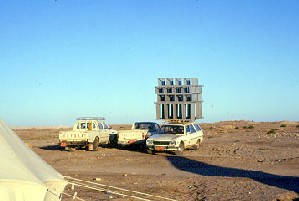

The expedition itself comprises a sizeable group of people. In 2000, the field team consisted of 38 archaeologists (not all present in Berenike at any time), five supporting staff (cook, driver etc.), three inspectors of the Supreme Council of Antiquities and about 80 Ababda workmen.
Water for drinking and washing has to be brought in, in the past from a well 130 km (80 m) to the south and since the beginning of the new millennium from a newly built desalination plant about 30 km (20 m) to the north. Food is transported from Quseir, 300 km (190 m) to the north, or even from Hurghada or Cairo. The expedition team resides in tents but can make use of the storage and work facilities in the Ababda Museum built on site by the Netherlands Ministry of Foreign Affairs. The expedition owns two battered vehicles, and rents a third one, to provide the camp with food and to go out in the desert for survey work. Solar panels generate electricity to operate computers, printers and microscopes. Food is prepared on butagas stoves and meals are served in a large dinner tent. After sunset, light is provided by kerosene lamps, candles and flashlights. Sanitary arrangements include solar heated showers and latrines dug by volunteers.
The Project appreciates the support of the Supreme Council of Antiquities as well as the support and co-operation of many who make their contribution not in Berenike but from a distance. The excavation works with a staff of Ababda Bedouin from the neighbouring villages of Arab Saleh and Manazig, as well as from Mersa Alam and the Aswan region. Apart from working on site, they receive training in archaeological techniques, recording systems and the preservation of desert sites. Their knowledge of the area is of great value for the desert survey during which many ancient roads, mines, quarries and settlements have been discovered, mapped and studied. Members of the Berenike Project participate in the study of the contemporary material culture and daily life of the Ababda, in order to preserve a detailed description of these for the future as well as to better understand some of the ancient material remains unearthed at Berenike.